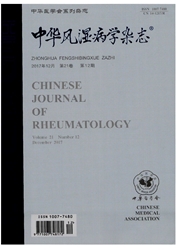

 中文摘要:
中文摘要:
目的分析SLE肠系膜血管炎(LMV)合并泌尿道受累临床及实验室特征和相关危险因素。方法入组本院2009-2015年期间住院LMV患者82例,回顾性分析比较LMV合并泌尿道受累与无泌尿道受累组临床及实验室特征;2组非正态分布的计量资料比较采用Mann-WhitneyU检验,呈正态分布的计量资料采用t检验;计数资料组间比较采用χ2检验;采用多元Logistic回归分析合并泌尿道受累相关危险因素。结果SLE中LMV的发生率为4.67%(82/1755).LMV合并泌尿道受累(LMV+U组)24例(29.3%),其中出现假性肠梗阻合并泌尿道受累(IPO+U组)11例(13.4%)。单纯LMV与LMV+U组年龄、性别和病程差异无统计学意义。但LMV+U组尿蛋白定量(24h)为(1.3±2.2)g/d,高于单纯LMV组的(0.8±1.2)g/d(t=2.871,P=0.04)。LMV+U组重度狼疮活动(SLEDAI〉15分)比例为41.7%,显著高于单纯LMv组的29.6%(χ2=4.272,P=0.02)。其中IPO+U组尿蛋白定量(24h)[(1.6±2.8)洲和(1.3±2.2)州,t=2.011,P=-0.02]、重度SLE活动比例(63.6%和41.7%,χ2=5.272,P=0.02)及抗SSA抗体阳性患者比例(90.9%和70.8%,χ2=4.115,P=0.02)较LMV+U组增加尤为明显(P分别为0.02,0.02和0.04)。多元Logstic回归分析显示尿蛋白定量(24h)(OR=1.12,P=0.03)和SLEDAI〉15分(OR=1.21,P=0.05)是LMV合并泌尿道受累的危险因素。结论泌尿道受累常和LMV相伴发,是LMV重度病情活动的标记之一。
 英文摘要:
英文摘要:
Objective To analyze the clinical and laboratory features of Lupus mesenteric vasculitis (LMV) with urinary tract involvement. Methods Eighty two LMV patients hospitalized to our hospital from 2009 t0 2015 were recruited into this study. The clinical and laboratory features of LMV with or without urinary tract involvement were retrospectively analyzed. Results The prevalence of LMV in systemic lupus erythematosus (SLE) patients with SLE (LMVU group) was 4.67% (82/1 755). The prevalence of LMV with urinary tract involvement was 29.3% (24/81) and intestinal pseudo-obstruction (IPO) with urinary tract involvement(IPOU group) was 13.4% (11/24). There was no difference in age, gender and disease duration between the LMV, LMVU and IPOU group. Twenty-four hours urinary protein content in the LMVU and IPOU group was (1.3±2.2) g/d and (1.6±2.8) g/d, respectively, which was higher than those in the LMV without urinary tract involvement group [(0.8±1.2)g/d] (t=2.871, P=-0.04 and t=2.011, P=0.02, respectively). Percentage of severe active lupus defined as systemic lupus erythematosus disease activity index (SLEDAI)〉 15 showed a significant increased trend in :these three groups (29.6%, 41.7% and 63.6%, respectively) and percentage of anti-SSA was also increased ih the IPOU group compared with those in the LMY group (90.9% vs 64.2%, X2=4.115, P=0.02). Multivariate logistic regression analysis indicated that SLEDAI〉15 and 24h urinary protein content were nsk factors for LMV with urinary tract involvement (OR=1.12, P=0.03 and OR=1.21, P=0.05, respectively). Conclusion Urinary tract iuvalvement is often accompanied with LMV and associates with severe disease activity.
 同期刊论文项目
同期刊论文项目
 同项目期刊论文
同项目期刊论文
 Adiponectin exacerbates collagen-induced arthritis via enhancing Th17 response and prompting RANKL e
Adiponectin exacerbates collagen-induced arthritis via enhancing Th17 response and prompting RANKL e Interleukin-29 induces receptor activator of NF-kappaB ligand expression in fibroblast-like synovioc
Interleukin-29 induces receptor activator of NF-kappaB ligand expression in fibroblast-like synovioc Inhibitory Effect of a Novel Antirheumatic Drug T-614 on the IL-6-Induced RANKL/OPG, IL-17, and MMP-
Inhibitory Effect of a Novel Antirheumatic Drug T-614 on the IL-6-Induced RANKL/OPG, IL-17, and MMP- Modulatory Effect of 1,25-Dihydroxyvitamin D 3 on IL1 beta -Induced RANKL, OPG, TNF alpha , and IL-6
Modulatory Effect of 1,25-Dihydroxyvitamin D 3 on IL1 beta -Induced RANKL, OPG, TNF alpha , and IL-6 Correlation of increased blood levels of GITR and GITRL with disease severity in patients with prima
Correlation of increased blood levels of GITR and GITRL with disease severity in patients with prima IL-29 enhances Toll-like receptor-mediated IL-6 and IL-8 production by the synovial fibroblasts from
IL-29 enhances Toll-like receptor-mediated IL-6 and IL-8 production by the synovial fibroblasts from A coronary artery disease-associated SNP rs6903956 contributed to asymptomatic hyperuricemia suscept
A coronary artery disease-associated SNP rs6903956 contributed to asymptomatic hyperuricemia suscept 期刊信息
期刊信息
